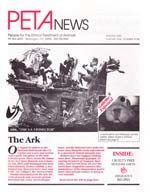PeTA News, Various issues (1985-1990. Washington, D.C.)
“Why Property Damage? ALF action goes beyond acts of protest. Animals will always be rescued where possible, but the main purpose of the action is often economic sabotage. Property and “things” hold no sacred value-the opposite, in fact, if they are used to cause pain and death. To STOP the very real violence of torture and killing, inanimate objects must be rendered unusable. When equipment is broken, work cannot go on as usual with a new batch of victims, insurance rates go up and so do security costs, making the enterprise less profitable.” PeTA News, Volume 2 #1
“When questioned on Irish television about an action against a butcher shop, Morrissey, an avid vegetarian, was asked “What about the safety of the butchers?” Responded Morrissey, “When you think of the horror experienced by millions of animals in slaughterhouses each year, what’s a few butchers?” His song Meat Is Murder topped the charts in 1985.” PeTA News Volume 3 #1
Imagine for a moment that a young animal rights activist with very little knowledge of the movement’s history finds a time machine and heads back into the early 1980s. Upon arrival they decide to get involved with a militant group and begin asking who they should join. At every turn they are told that PETA is the most militant group in the United States. This seems absurd to our young activist! “All PETA does is embarrass the movement with offensive ad campaigns and nudity! They are celebrity driven and devoid of substance, they kill healthy feral cats and don’t even have a rights based philosophy! They even demoted an employee for publicly supporting politically motivated arson!” Angered, our imaginary friend stomps into the DC area offices of the group to re-write history, and is shocked with what they find…
People for the Ethical Treatment of Animals experienced a meteoric rise in membership and notoriety in the early 1980’s as a direct result of their support for (and participation in) illegal direct action. Their relationship with the Animal Liberation Front was symbiotic: PETA provided the ALF with whistlebower information, credible spokespeople, and sympathetic coverage of raids. In return, PETA was placed in the media spotlight and received undercover footage and documents from the ALF that were often parlayed into high profile (and lucrative) campaigns. The atmosphere of popular militancy was exciting, and after years of slow progress people felt that supporting PETA meant backing a faster, more direct path to rights for non-humans.
PETA sold ALF support merchandise in their newsletters, ran a legal defense fund for people accused of unlawful activism, and helped popularize the concept of mischief in defense of animals. For example, PETA News sold squirt bottles of red permanent fabric ink alongside the warning that since the damage done to furs would be permanent, you should only spray the ink on your own furs! Articles talked about a likely apocryphal 15 year old who got grounded for passing out “Throw a Brick Through McDonald’s Day” pamphlets, and later chuckled as he got caught with paint bombs under his bed. Incidentally, the same article described how young “Kevin” made the paint bombs. These examples only just barely scratch the surface of the early militancy of Alex Pacheco and Ingrid Newkirk’s fledgling organization.
The story of animal rights in the United States can not be told without a thorough examination of the early days of PETA, an era sure to shock newcomers. In the coming months we will begin a more in depth analysis of their early days, but in the meantime jump into the TALON time machine and prepare to have your mind blown by these early issues of PeTA News.









» Got the Hollowpoints for the Snitches




